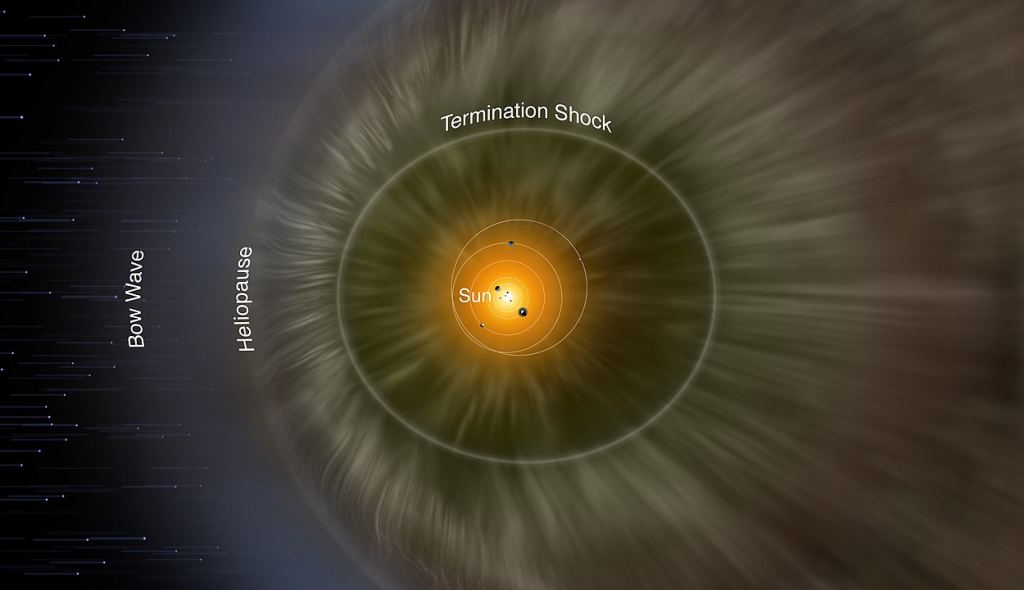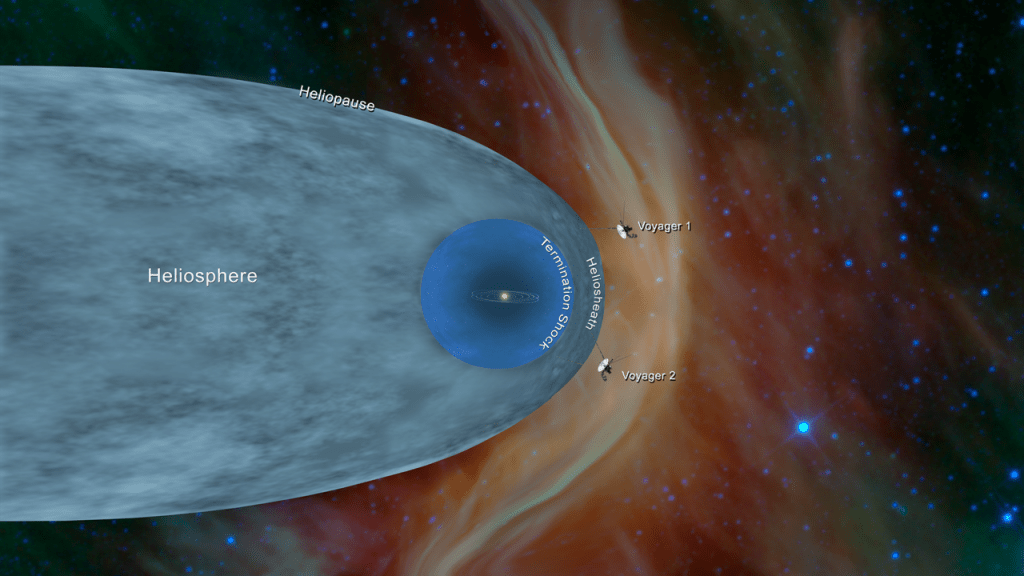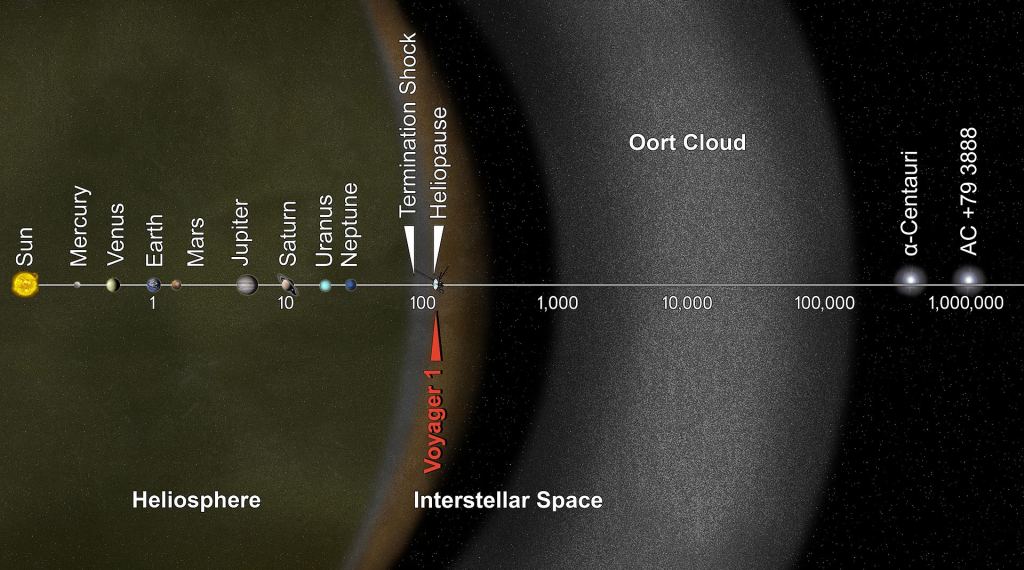Only two of humanity’s spacecraft have left the Solar System: NASA’s Voyager 1 and Voyager 2. Voyager 1 left the heliosphere behind in 2012, while Voyager 2 did the same on Nov. 5th, 2018. Now Voyager 2 has been in interstellar space for one year, and five new papers are presenting the scientific results from that one year.
The heliosphere is a bubble-shaped region of space with our Sun in the center. Think of it as an inflated cavity full of plasma that comes from the Sun. The edge of the bubble is where the plasma from our Sun gives way to the interstellar medium (ISM.) Voyager 2 left the heliosphere behind and entered interstellar space at about 18 billion km (11 billion miles) from Earth.
Each of the five papers contains results from one of Voyager 2’s five scientific instruments:
- magnetic field sensor
- two instruments that detect energetic particles in different energy ranges
- two instruments that study plasma
It’s remarkable that these instruments, designed and built decades ago, are still functioning and collecting new data.
It’s taken decades for Voyager 2 to reach the heliopause, the demarcation between interstellar space and our Solar System. As only the second spacecraft to reach it, Voyager 2 is in a position go give us unique scientific insights into this region. They’re unique because Voyager 1 left the heliosphere at a different location, six years prior. Voyager 2’s data is also unique because one of its instruments, used to measure plasma, is still operating while the counterpart instrument on Voyager 1 stopped functioning decades ago.

The Sun operates on an 11-year cycle, and its output changes during that cycle. There’s a debate about the overall shape of the heliosphere, but through the 11 year cycle, the size and shape can change. Each of the Voyager probes encountered the heliopause at about the same distance, but Voyager 2 encountered the termination shock about 1 billion miles closer to the Sun than Voyager 1. The probes left the heliosphere at different locations, and each of the Voyager probes has something different to tell us.
Right now, Voyager 2 is in a transitional region of space on the edge of the heliosphere, not quite in undisturbed interstellar space.
Ed Stone is a physics professor at Caltech and a project scientist for the Voyager program. In a press release, he said, “The Voyager probes are showing us how our Sun interacts with the stuff that fills most of the space between stars in the Milky Way galaxy. Without this new data from Voyager 2, we wouldn’t know if what we were seeing with Voyager 1 was characteristic of the entire heliosphere or specific just to the location and time when it crossed.”

Voyager 1 left the heliosphere near the front as the Solar System travels through the space. Think of it as the prow of a ship. Voyager 2 left the heliosphere on the flank.
The Results
Both Voyager probes have told us that the plasma in local interstellar space is more dense than the plasma inside the heliosphere. Scientists expected those findings. Now that Voyager 2 has left the heliosphere, we know that the same local interstellar plasma is also colder than the plasma inside the heliosphere.
When Voyager 1 left the heliosphere behind in 2012 it measured the density of the plasma just outside the heliosphere and found that it was higher than expected. This indicates that it’s being compressed. Voyager one found that the same region of plasma is also warmer than expected, which also indicates compression, though the exterior plasma is still colder than the interior plasma.
Voyager 2 also measured a light increase in density in the plasma just inside the heliosphere, indicating that its compressed, too. But so far, scientists don’t have an explanation.

Data shows that the flank where Voyager 2 left the heliosphere may be somewhat “porous” compared to where Voyager 1 departed. Voyager 2 detected a trickle of particles “leaking” from the heliosphere into interstellar space.
Voyager 1 found a surprise when it left the heliosphere. The magnetic field just beyond the heliopause is parallel to the field inside the heliosphere. At the time, scientists couldn’t say if that was just an anomaly. But now Voyager 2 has detected the same magnetic alignment.
The Voyager probes were never meant to last this long. Their journey has been remarkable, and has taught us a lot. Before they reached the heliopause, scientists thought that the solar wind would fade away gradually. But instead, we know that there’s more of a distinct boundary, indicated by lower temperature and increased density.
The Voyager probes have revealed other surprises. In 2011 they showed us that the heliopause is not a smooth region. It contains magnetic bubbles that likely form when the Sun’s magnetic field is warped at the edge of the Solar System.
The end is in sight for the Voyager Program. Eventually, their power will run down. NASA intends to shut down instruments one by one, in order to extend the mission as long as possible. But sometime around 2025, the last instrument will run out of power. Then the Voyager probes will just continue to follow their trajectory.
What their ultimate fate is, we’ll never know.
More:
- Press Release: Voyager 2 Illuminates Boundary of Interstellar Space
- Research Paper: Heliosheath Properties Measured from a Voyager 2 to Voyager 1 Transient
- Universe Today: NASA has Figured Out How to Extend the Lives of the Voyagers Even Longer

